Modernization of a Tube Furnace as Part of Zero-Waste Practice
Abstract
1. Introduction
Overview of Thermal Methods
2. Methodology
- Analysis of the current technical condition of the RST 20x200/100M/spec research station.
- Disassembly of existing components.
- Installation of a new support structure.
- Selection and installation of the furnace rotation mechanism.
- Selection and installation of the balance table system.
- Fabrication of a rod-type device for sample insertion into the furnace.
- Testing of the modernized research station, including thermal analysis in the inverted configuration.
2.1. Structure of the Research Station Before Modernization
2.2. Modernization of the Research Station
2.3. Research Station After Modernization
2.4. Evaluation of the Effectiveness of Using Recycled Components
2.5. Verification and Testing of the Research Station
3. Summary and Conclusions
Author Contributions
Funding
Institutional Review Board Statement
Informed Consent Statement
Data Availability Statement
Acknowledgments
Conflicts of Interest
References
- Walasek, M. Startup z Togo Tworzy Drukarki 3D z Odpadów Elektronicznych. 3D.edu.pl. Available online: https://3d.edu.pl/startup-z-togo-tworzy-drukarki-3d-z-odpadow-elektronicznych/ (accessed on 14 August 2025).
- Walasek, M. Oddział Szpitalny z Recyklingu. Świat OZE. Available online: https://swiatoze.pl/oddzial-szpitalny-z-recyklingu (accessed on 14 August 2025).
- Politechnika Warszawska. Od Elektroodpadów Do Katalizatorów Przemysłowych; Politechnika Warszawska: Warsaw, Poland, 2024. [Google Scholar]
- Zhang, Z.; Xu, C.; Cheng, G.; Lau, E.V. Towards Carbon Neutrality: A Comprehensive Study on the Utilization and Resource Recovery of Coal-Based Solid Wastes. Int. J. Coal Sci. Technol. 2025, 12, 34. [Google Scholar] [CrossRef]
- Cheng, G.; Zhang, M.; Lu, Y.; Zhang, Y.; Lin, B.; Lau, E.V. A Novel Method for the Green Utilization of Waste Fried Oil. Particuology 2024, 84, 1–11. [Google Scholar] [CrossRef]
- Nowak, K.; Wyrzykowski, J. Analiza Termiczna: Metody i Zastosowania; AGH: Kraków, Poland, 2018. [Google Scholar]
- Wielgosiński, G. Termiczne Przekształcanie Odpadów Komunalnych—Wybrane Zagadnienia; Nowa Energia: Gliwice, Poland, 2016. [Google Scholar]
- Bałazińska, M. Analiza Life Cycle Assessment Spalania Biomasy i Odpadów Dla Celów Energetycznych. Polityka Energetyczna 2013, 16, 221–231. [Google Scholar]
- Gadomski, W.; Zając, M. Zastosowania Analizy Termicznej w Przemyśl; Wydawnictwo Naukowe PWN: Warszawa, Poland, 2013. [Google Scholar]
- Wunderlich, B. Differential Scanning Calorimetry of Polymers; Academic Press: Cambridge, MA, USA, 1990. [Google Scholar]
- Chiu, J. Thermogravimetric Analysis of Polymers; Wiley: Hoboken, NJ, USA, 2001. [Google Scholar]
- Ward, I.M.; Sweeney, J.C. Thermomechanical Analysis of Polymers; Elsevier: Amsterdam, The Netherlands, 2004. [Google Scholar]
- Kremer, F.; Schönhals, A. Dielectric Spectroscopy of Polymers; Springer: Berlin/Heidelberg, Germany, 2003. [Google Scholar]
- Leary, J.M. Evolved Gas Analysis; Elsevier: Berlin/Heidelberg, Germany, 2013. [Google Scholar]
- Sawyer, L.C.; Grubb, D.T. Thermal Microscopy of Polymers; Hanser Publications: Munich, Germany, 1996. [Google Scholar]
- Urban, M.W. Infrared and Raman Spectroscopy of Polymers; Hanser Publications: Munich, Germany, 2001. [Google Scholar]
- Gerrard, D.L. Raman Spectroscopy of Polymers; Wiley: Hoboken, NJ, USA, 1991. [Google Scholar]
- McKeever, S.W.S. Thermoluminescence of Solids; Cambridge University Press: Cambridge, UK, 1985. [Google Scholar]
- Kemp, R.B. Microcalorimetry and Its Applications in Biology; Elsevier: Amsterdam, The Netherlands, 2007. [Google Scholar]
- Kruse, P.W. Thermography and Thermographic Imaging; CRC Press: Boca Raton, FL, USA, 2001. [Google Scholar]
- Mettler Toledo Thermal Analysis System DSC 3—Differential Scanning Calorimetry Instrument. Available online: https://www.mt.com/us/en/home/products/Laboratory_Analytics_Browse/TA_Family_Browse/ta-instruments/thermal-analysis-system-DSC-3.html (accessed on 13 August 2025).
- Mettler Toledo Thermal Analysis System TGA 2—Thermogravimetric Analyzer. Available online: https://www.mt.com/us/en/home/products/Laboratory_Analytics_Browse/TA_Family_Browse/ta-instruments/thermal-analysis-system-TGA-2.html (accessed on 13 August 2025).
- TA Instruments TMA, 450 Thermomechanical Analyzer. Available online: https://www.tainstruments.com/products/thermal-analysis/thermomechanical-analyzers/ (accessed on 13 August 2025).
- TA Instruments RSA-G2 Solids Analyzer—Dynamic Mechanical Analyzer Platform. Available online: https://www.tainstruments.com/rsa-g2/ (accessed on 13 August 2025).
- NETZSCH Analyzing & Testing DEA, 288, Epsilon Dielectric Analyzer. Available online: https://analyzing-testing.netzsch.com/en-US/products/dielectric-analysis-dea/dea-288-ionic (accessed on 13 August 2025).
- NETZSCH Analyzing & Testing Evolved Gas Analysis System Coupled with Mass Spectrometer. Available online: https://analyzing-testing.netzsch.com/en-US/services/contract-testing/methods/hyphenated-techniques-ega-1 (accessed on 13 August 2025).
- Linkam Scientific Instruments Thermal Microscope—Hot Stage Microscopy Systems. Available online: https://www.linkam.co.uk/thermal-analysis (accessed on 13 August 2025).
- Thermo Fisher Scientific Nicolet IS Series FTIR Spectrometer. Available online: https://www.thermofisher.com/us/en/home/industrial/spectroscopy-elemental-isotope-analysis/molecular-spectroscopy/fourier-transform-infrared-spectroscopy/instruments/nicolet-is50-ftir-spectrometer.html (accessed on 13 August 2025).
- Renishaw plc. inVia Confocal Raman Microscope—Specifications. Available online: https://www.renishaw.com/en/invia-confocal-raman-microscope--6260 (accessed on 13 August 2025).
- Risø National Laboratory (DTU Physics) TL/OSL Reader—Thermoluminescence and Optically Stimulated Luminescence Measurement System. Available online: https://luminescence.dk/reader.html (accessed on 13 August 2025).
- Teledyne FLIR. FLIR Axxx—Series Fixed-Mount Thermal Cameras (A400-A700 Series). Available online: https://www.flir.com/instruments/a400-a700-series/ (accessed on 13 August 2025).
- TA Instruments TAM III Microcalorimeter—Thermal Activity Monitor. Available online: https://www.tainstruments.com/tam-iii/ (accessed on 13 August 2025).
- Malvern Panalytical MicroCal PEAQ-ITC—Isothermal Titration Calorimeter. Available online: https://www.malvernpanalytical.com/en/products/product-range/microcal-range/microcal-itc-range/microcal-peaq-itc (accessed on 13 August 2025).
- TA Instruments Q2000 Series Differential Scanning Calorimeter (Modulated DSC Option). Available online: https://www.tainstruments.com/pdf/brochure/DSC.pdf (accessed on 13 August 2025).
- NETZSCH Analyzing & Testing. Analizator Termiczny STA 449 F3 Jupiter—Analiza DTA/TGA-DSC. Available online: https://analyzing-testing.netzsch.com/en-US/products/simultaneous-thermogravimetry-differential-scanning-calorimetry-sta-tg-dsc (accessed on 13 August 2025).
- NETZSCH Analyzing & Testing. Eplexor Dynamic Mechanical Analyzer (DMA). Available online: https://analyzing-testing.netzsch.com/en-US/products/dynamic-mechanical-analysis-dma (accessed on 13 August 2025).
- Novocontrol Technologies Concept 80 Broadband Dielectric Spectrometer. Available online: https://www.novocontrol.de/php/index.php (accessed on 13 August 2025).
- Novocontrol Technologies. TSDC System—Thermally Stimulated Depolarization Current System. Available online: https://web.archive.org/web/20250812204219if_/https://www.novocontrol.de/php/tsdc.php (accessed on 13 August 2025).
- Nabertherm Wysokotemperaturowe Piece Rurowe z Prętami Grzewczymi z SiC Do 1600 °C. Available online: https://nabertherm.com/pl/produkty/labor/piece-rurowe/wysokotemperaturowe-piece-rurowe-z-pretami-grzewczymi-z-sic-do-1600 (accessed on 13 August 2025).
- Carbolite Gero Ltd. High Temperature Vertical Tube Furnace—HTRV. Available online: https://www.carbolite.com/products/tube-furnace-range/universal-tube-furnaces/htrv/ (accessed on 13 August 2025).
- Czylok Sp.z o.o. Piec Rurowy na Statywie Dzielony Typ RSD 20 × 200 M (Oznaczenie Pieca PID RSD 20 × 200/100)—Dokumentacja Techniczno-Ruchowa. Available online: https://www.czylok.com.pl/de/dla-laboratoriow/rsd/piec-rurowy-na-statywie-dzielony-typ-rsd-20x200m/ (accessed on 13 August 2025).
- ONKRON. TS1351 Mobile TV Stand User Guide. Available online: https://manuals.plus/onkron/ts1351-mobile-tv-stand-manual (accessed on 13 August 2025).
- SISO-POL Bobin sc. Obrotnica Meblowa z Mechanizmem Zwrotnym. Available online: https://www.siso-pol.pl/obrotnica-meblowa-z-mechanizmem-zwrotnym.html (accessed on 13 August 2025).
- Beer, F.P.; Johnston, E.R., Jr.; DeWolf, J.T.; Mazurek, D.F. Mechanics of Materials; McGraw-Hill Education: New York, NY, USA, 2011. [Google Scholar]
- Jaroniek, M. Podstawy Mechaniki Technicznej: Dla Studentów Wydziału Elektrotechniki i Elektroniki; Wydawnictwo Politechniki Łódzkiej: Łódź, Poland, 2004; ISBN 83-7283-111-4. [Google Scholar]
- Halliday, D.; Resnick, R.; Walker, J. Podstawy Fizyki; Państwowe Wydawnictwa Naukowe: Warszawa, Poland, 2013. [Google Scholar]
- Czermiński, J. Wytrzymałość Materiałów; Wydawnictwa Naukowo-Techniczne: Warsaw, Poland, 2002. [Google Scholar]
- PN-EN ISO 898-1:2013; Własności Mechaniczne Części Złącznych Wykonanych ze Stali Węglowej i Stopowej—Część 1: Śruby i Śruby Dwustronne. International Organization for Standardization: Geneva, Switzerland, 2013.
- UCHWYTY-TV.PL. Profesjonalny Stojak Pod Telewizor AVA1500. Available online: https://www.uchwyty-tv.pl/telewizja/profesjonalny-stojak-pod-telewizor-ava1500/ (accessed on 15 September 2025).
- ZŁOM INFO PL. Cennik Złomu na Tydzień Numer: 30, 2025 r. Available online: https://www.zlom.info.pl/cena-zlomu/srednie-ceny-zlomu/5126/ceny-zlomu-na-tydzien-numer-30-2025-r.html (accessed on 15 September 2025).
- ZŁOM Rzeszów. Cennik Złomu. Available online: https://www.zlomrzeszow.pl/cennik.html (accessed on 15 September 2025).
- ALLEGRO.PL. Podnośnik Nożycowy Platforma do 135 kg Motocyklowy. Available online: https://allegro.pl/oferta/podnosnik-nozycowy-platforma-do-135kg-motocyklowy-14012520455 (accessed on 15 September 2025).
- CZYLOK Sp. z o.o. Piece Rurowe na Statywie—Oferta Dla Laboratoriów. Available online: https://www.czylok.com.pl/dla-laboratoriow/piece-rurowe-na-statywie (accessed on 15 September 2025).
- FRUUGO Poland. Przepływomierz Gazu 1–10 LPM z Zaworem Regulacyjnym. Available online: https://www.fruugonorge.com/gas-flow-meter-1-10-lpm-flow-meter-with-regulating-valve/p-201676845-429081727?language=en (accessed on 15 September 2025).
- ALLEGRO.PL. Mała Mini Poziomica/Libelka 15 × 15 × 40 mm. Available online: https://allegro.pl/oferta/mala-mini-poziomica-poziomnica-libelka-libella-15x15x40mm-10858771179 (accessed on 15 September 2025).
- Gobbo, É.; Nia, E.M.; Straub, A.; Stephan, A. Exploring the Effective Reuse Rate of Materials and Elements in the Construction Sector. J. Build. Eng. 2024, 98, 111344. [Google Scholar] [CrossRef]
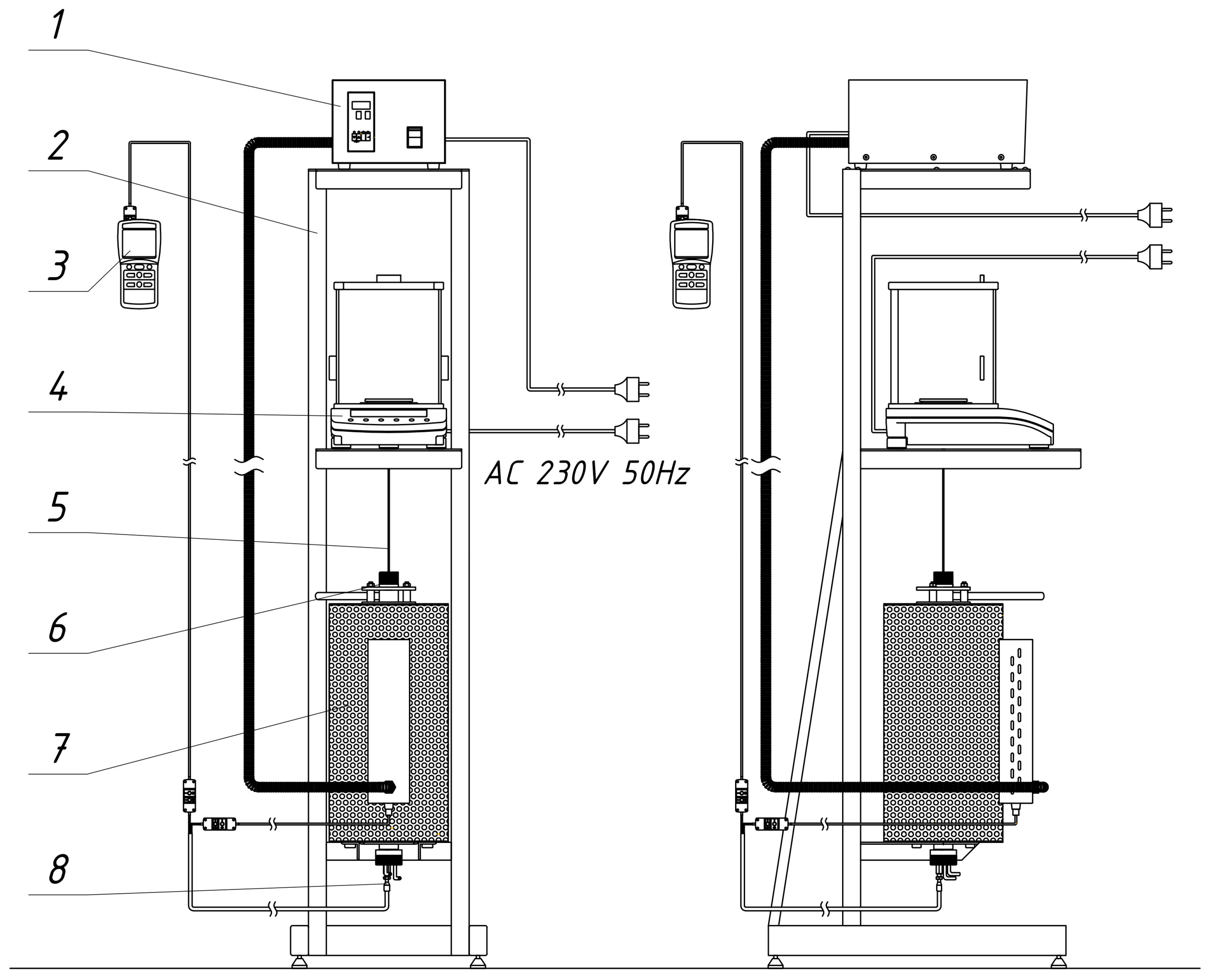
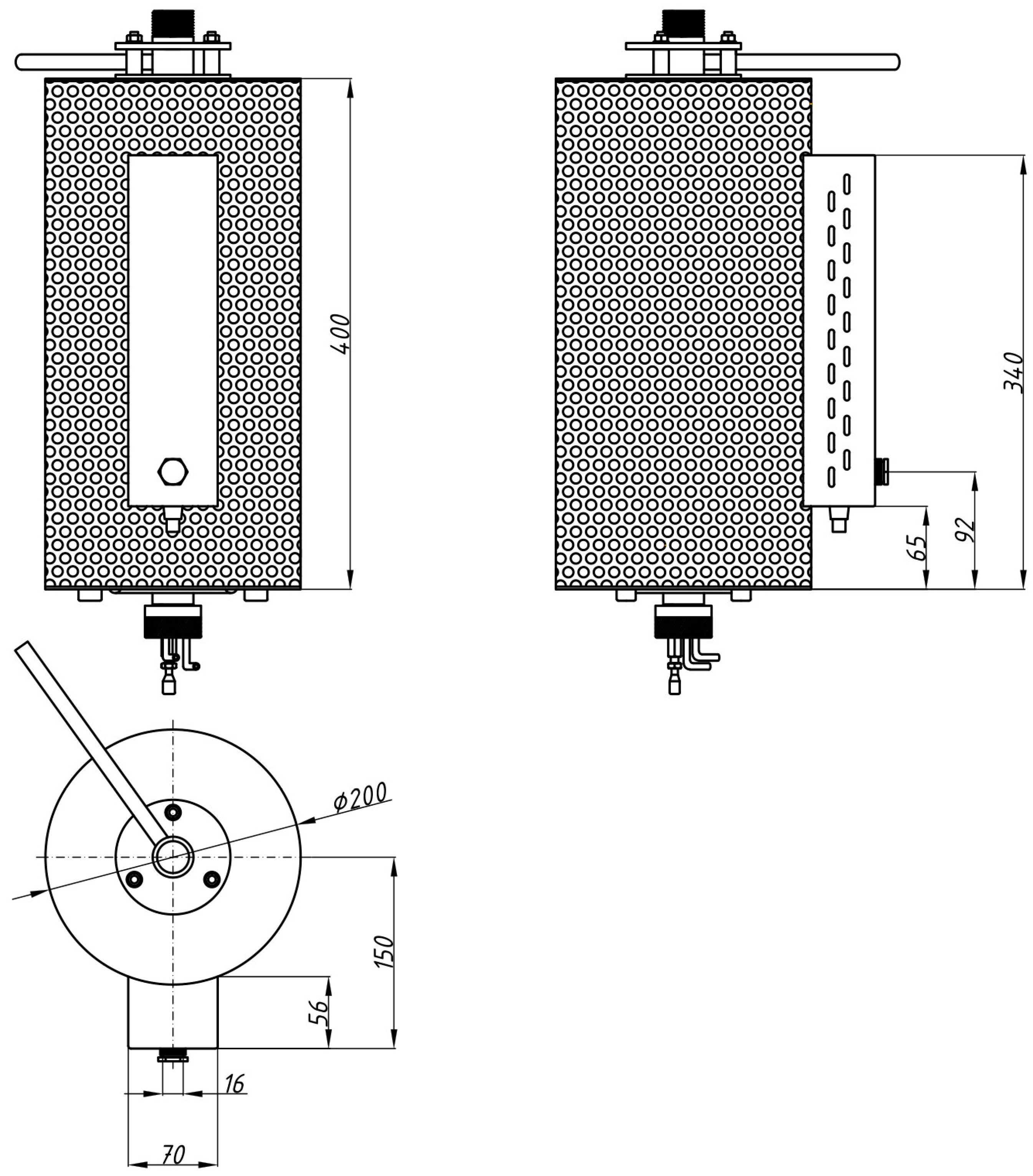
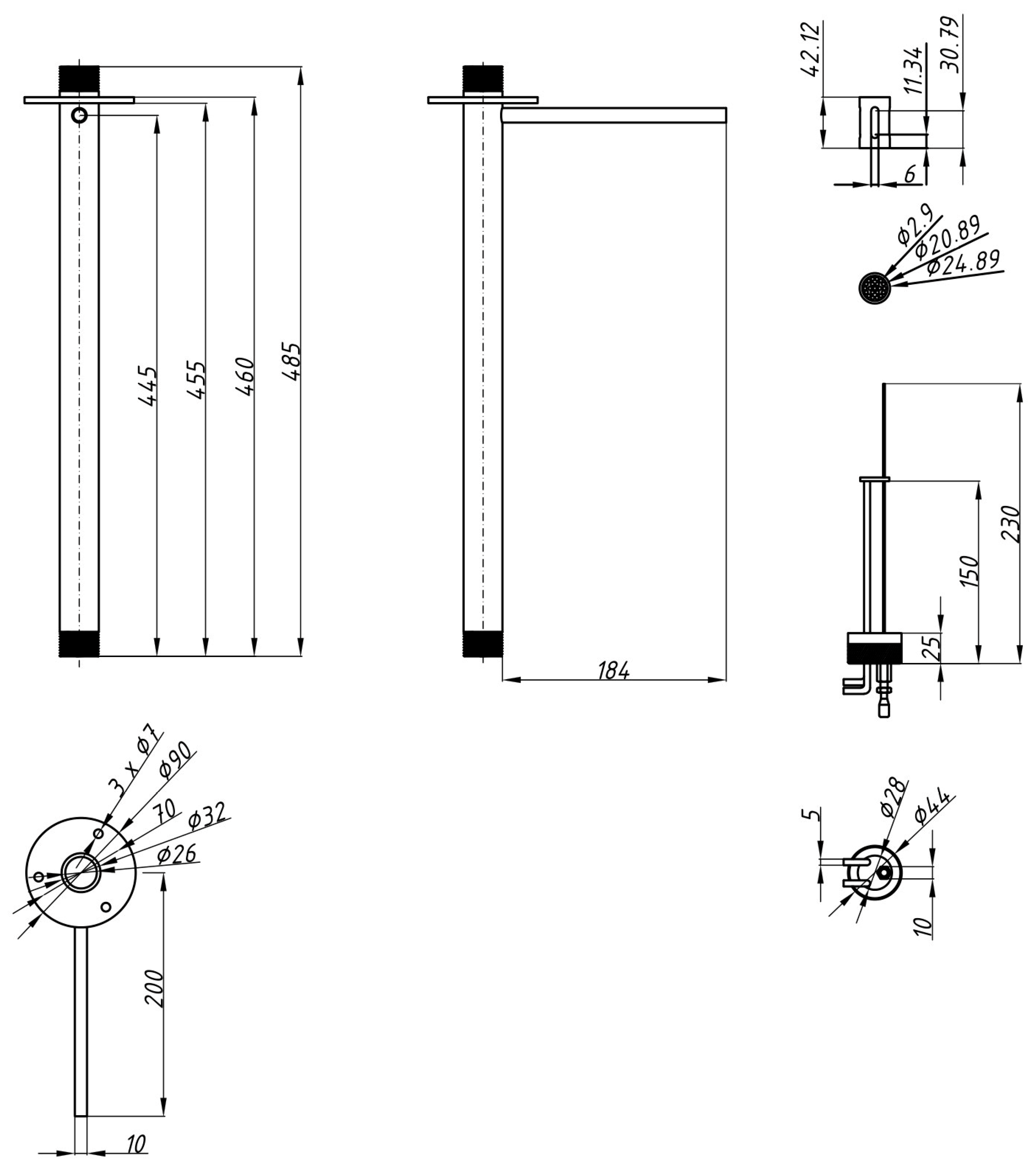
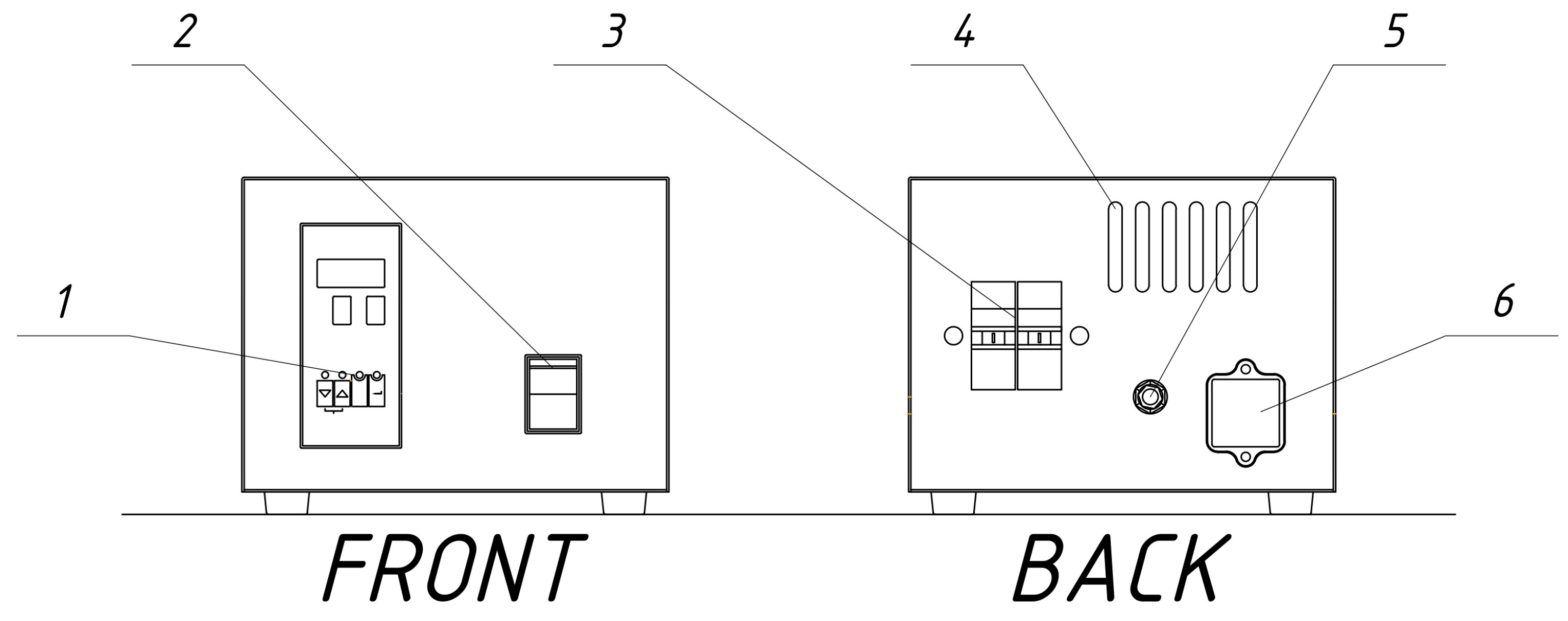

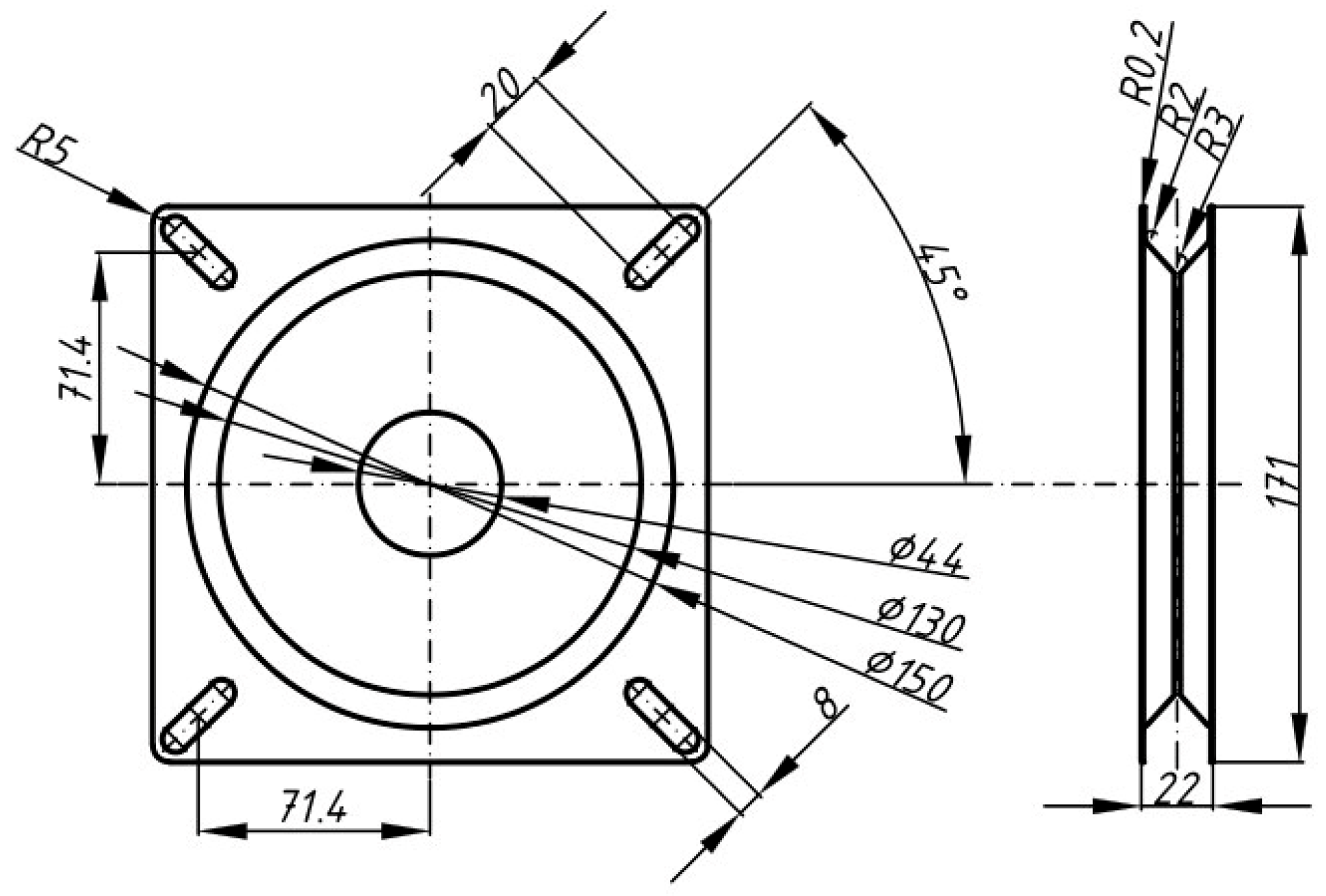
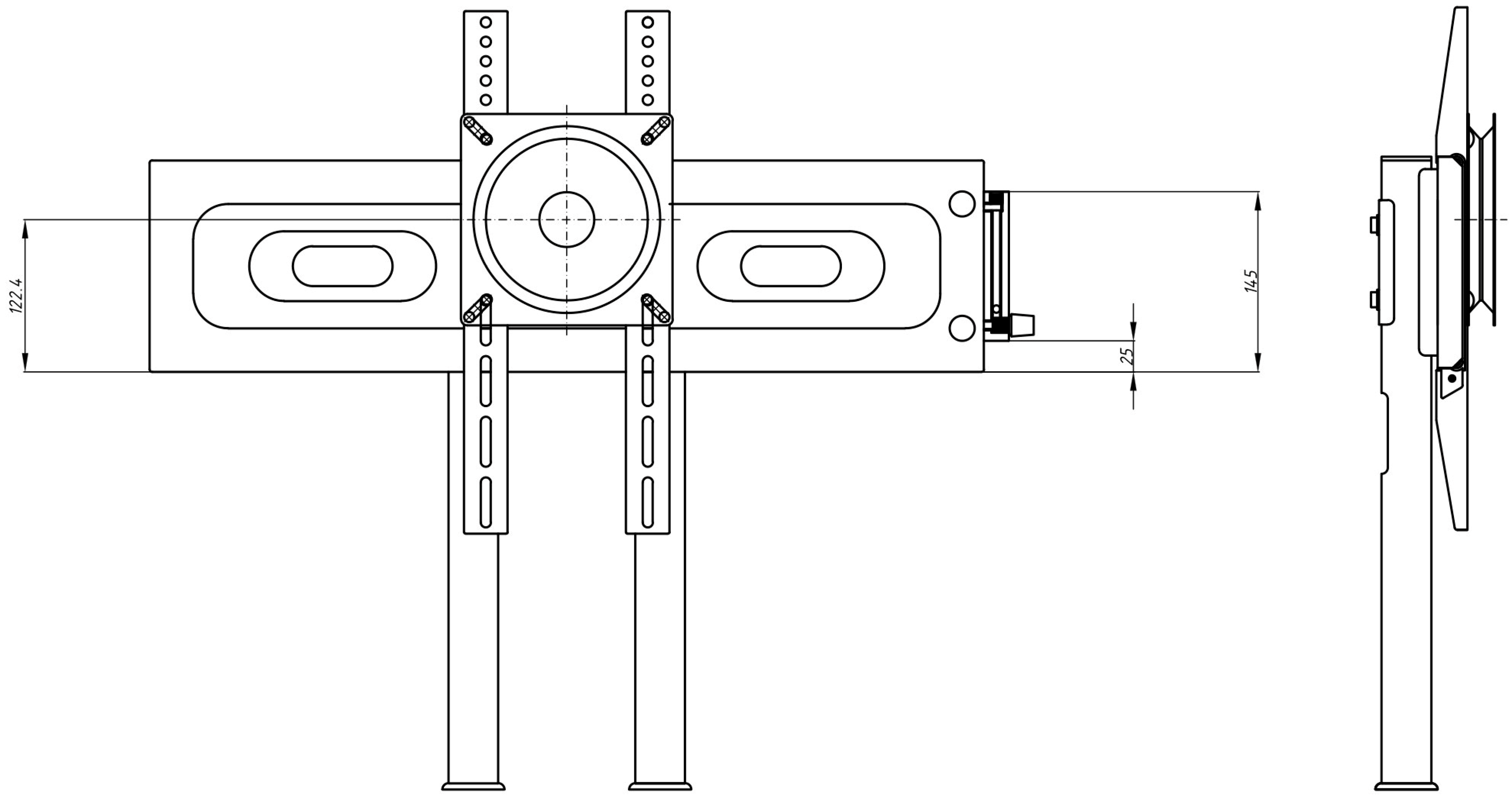
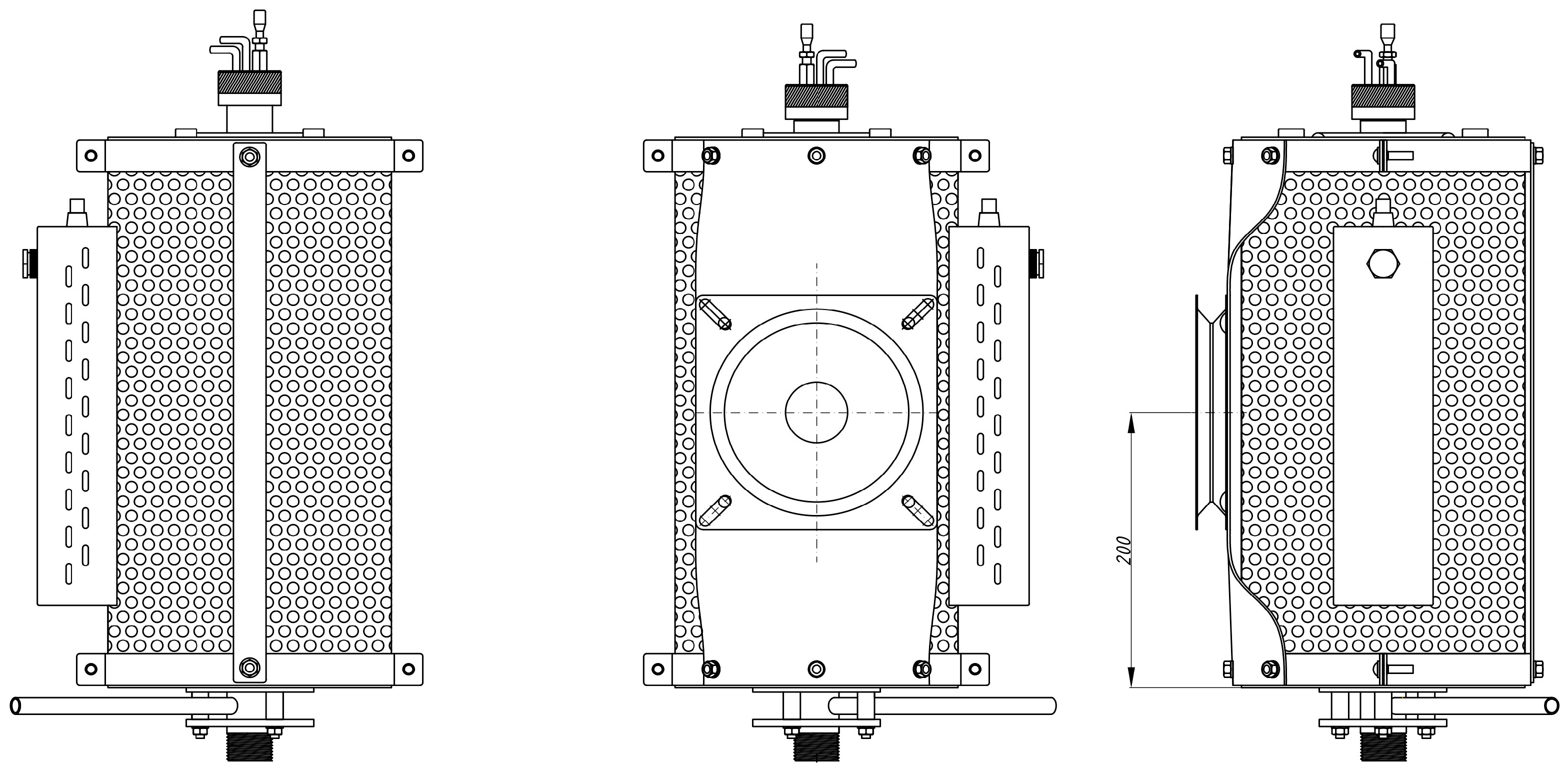
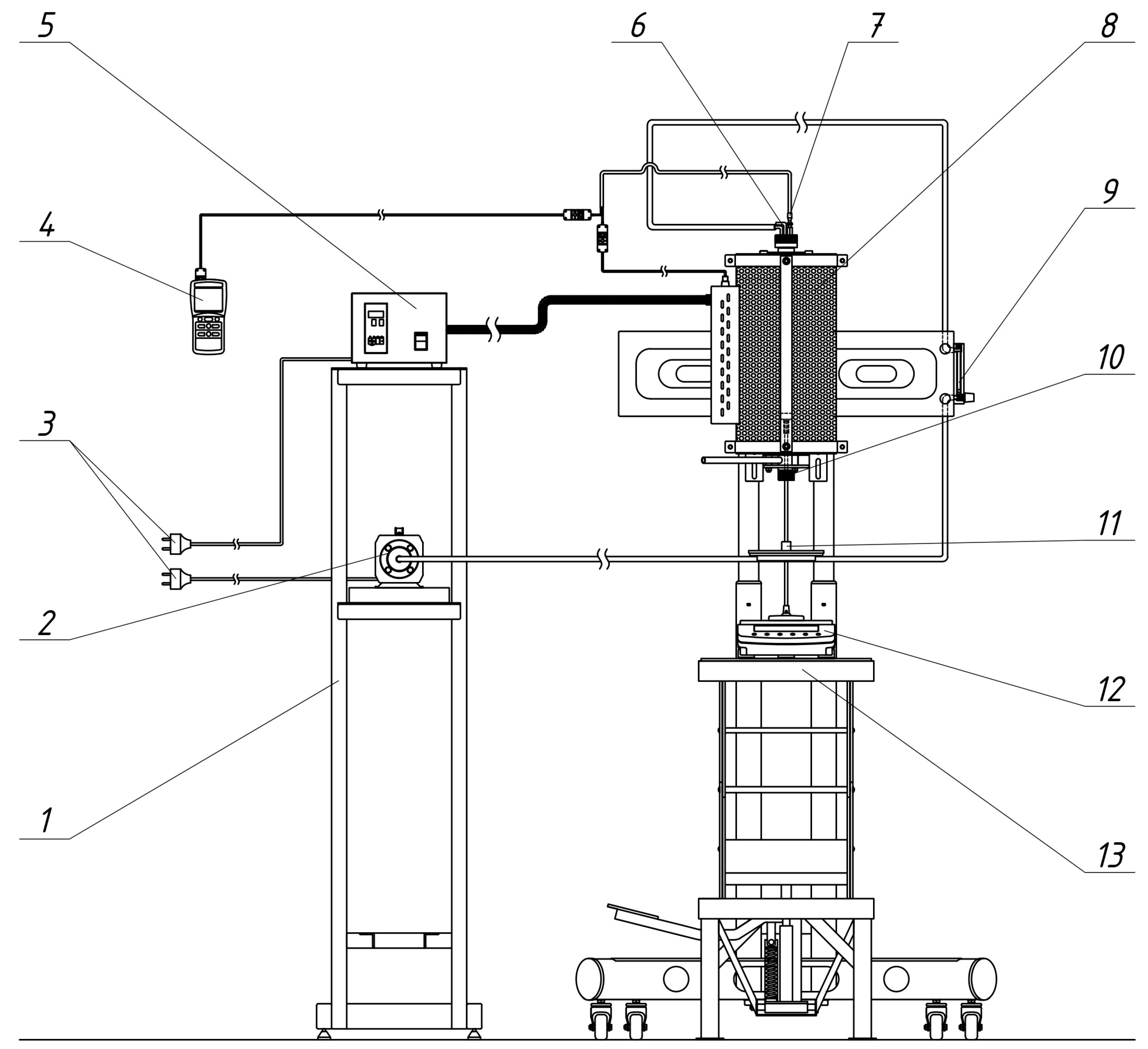
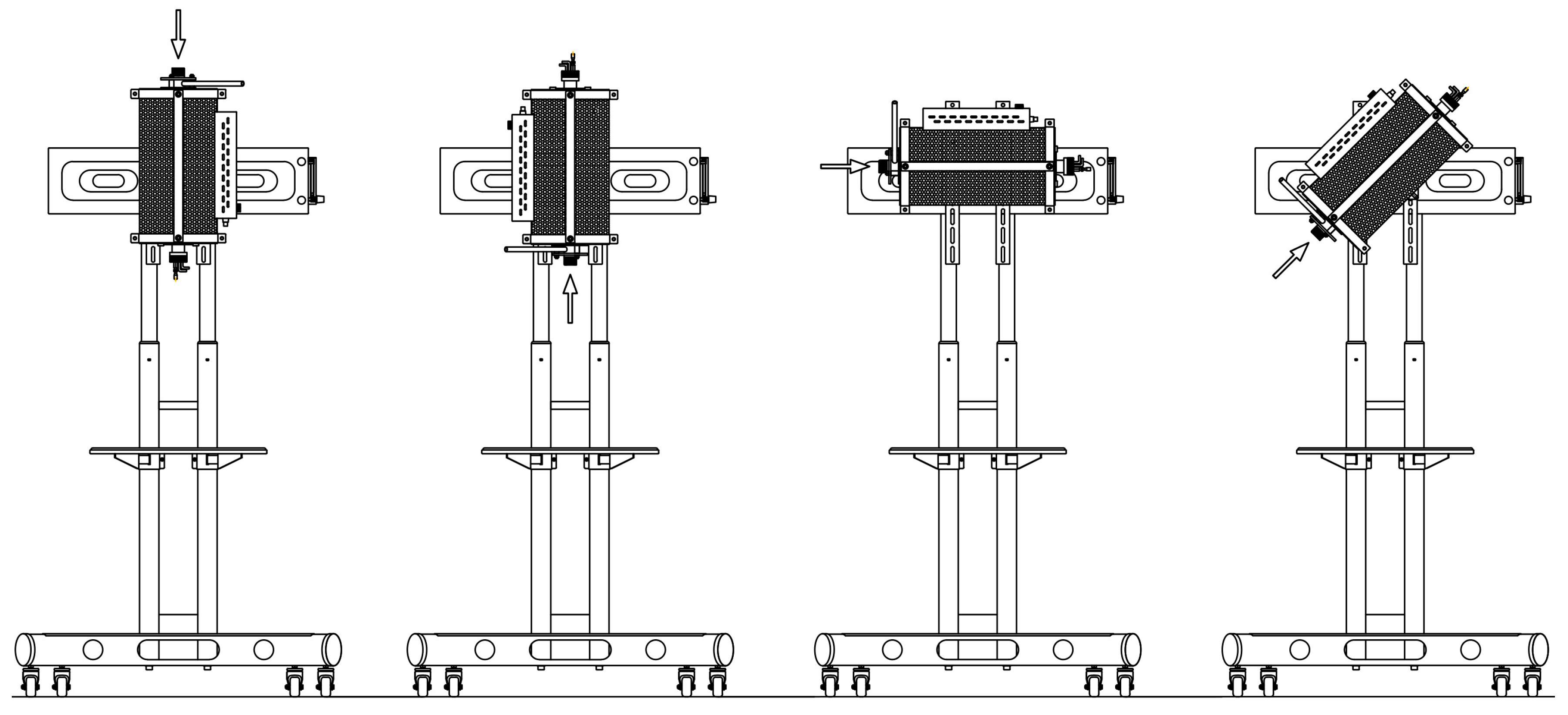
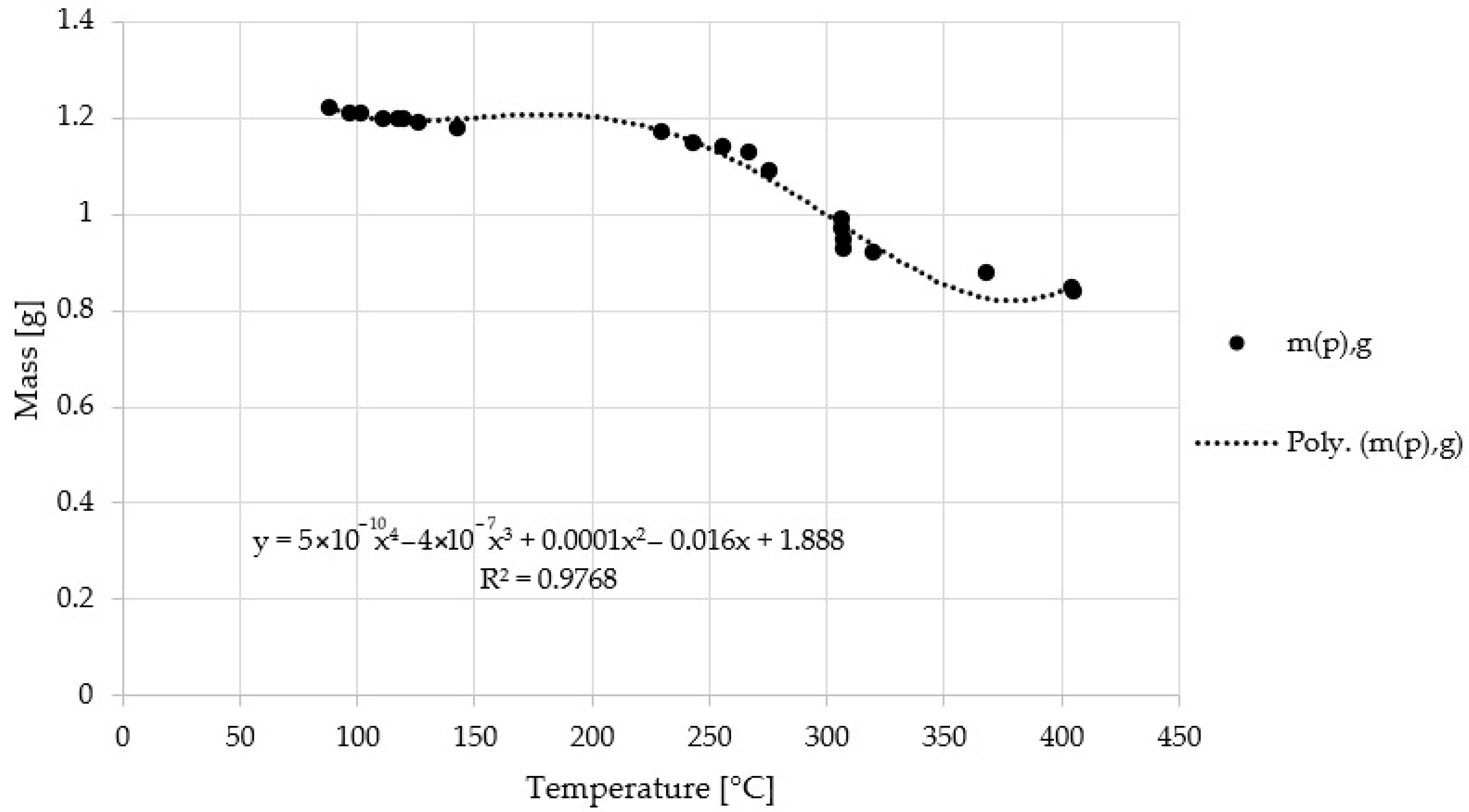

| Technique | Measured Property | Key Applications |
|---|---|---|
| DSC Differential Scanning Calorimetry | Enthalpy changes, specific heat capacity, phase transition temperatures (melting, crystallization, polymorphic transitions, glass transition), transformation kinetics | Purity analysis, polymorph identification, thermal stability analysis, investigation of polymer melting and crystallization processes, analysis of pharmaceuticals and food products [6,9,10] |
| TGA Thermogravimetric Analysis | Sample mass changes as a function of temperature or time, thermal decomposition, quantitative composition, thermal stability | Moisture content determination, analysis of thermal decomposition of polymers, composition analysis of mixtures, thermal stability testing of pharmaceuticals and construction materials [11] |
| TMA Thermomechanical Analysis | Dimensional changes of the sample in response to temperature (thermal expansion, shrinkage), elastic modulus, viscosity, stress relaxation | Thermal expansion studies of metals, polymers, and ceramics, analysis of material shrinkage, measurement of elastic modulus and viscosity [12] |
| DMA Dynamic Mechanical Analysis | Dynamic elastic modulus, damping factor, dynamic viscosity, stress relaxation under dynamic conditions | Investigation of elastic modulus and viscoelastic properties of polymers, composites, and elastomers; characterization of plastics; stress relaxation analysis; measurement of dynamic elastic modulus and damping factor [12] |
| DEA Dielectric Analysis | Changes in the dielectric properties of a material (dielectric constant, dielectric loss) as a function of temperature or frequency | Investigation of dielectric properties of polymers, ceramics, and composites; analysis of polarization and relaxation processes; monitoring of resin curing [13] |
| EGA Evolved Gas Analysis | Analysis of gases released from the sample during heating, identification of thermal decomposition products | Thermal decomposition studies of polymers, identification of degradation products, analysis of gases released during combustion [14] |
| TM Thermal Microscopy | Morphological changes of the sample (crystalline structure, phase transitions) as a function of temperature, observation of processes occurring during heating | Observation of melting and crystallization of polymers, analysis of phase transitions in metals and alloys, investigation of crystal morphology [15] |
| FTIR Fourier Transform Infrared Spectroscopy | Changes in the infrared spectrum of the material as a function of temperature, identification of functional groups, analysis of chemical composition | Investigation of structural changes in polymers, identification of thermal decomposition products, chemical composition analysis [16] |
| RS Raman Spectroscopy | Changes in the Raman spectrum of the material as a function of temperature, identification of functional groups, analysis of molecular structure | Investigation of structural changes in polymers, identification of functional groups, chemical composition analysis [17] |
| TL Thermoluminescence | Light emitted by the material after prior irradiation, temperature dependence of light emission | Study of luminescent materials, archaeological dating, radiation dosimetry [18] |
| MK Microcalorimetry | Heat released or absorbed during chemical and biological processes, enthalpy changes of reactions | Investigation of chemical reactions, biological processes (e.g., cellular metabolism), and intermolecular interactions [19] |
| ITC Isothermal Titration Calorimetry | Heat released or absorbed during interactions between two substances, reaction enthalpy, equilibrium constant, stoichiometry | Investigation of protein–ligand, enzyme–substrate, and DNA–drug interactions; analysis of association and dissociation processes [19] |
| MDSC Modulated Differential Scanning Calorimetry | Reversible and irreversible heat, specific heat, phase transition temperatures | Investigation of complex thermal transitions, analysis of structural relaxation, identification of processes occurring during glass transition [10] |
| DTA Differential Thermal Analysis | Temperature difference between the sample and the reference, phase transition temperatures | Investigation of phase transitions in minerals and ceramics, analysis of mixture composition [6] |
| DTMA Dynamic Thermomechanical Analysis | Dynamic elastic modulus, damping factor, and dynamic viscosity as a function of temperature and frequency | Investigation of viscoelastic properties of materials, stress relaxation analysis, measurement of dynamic elastic modulus and damping factor [12] |
| DRS Broadband Dielectric Spectroscopy | Changes in the dielectric properties of a material over a wide range of temperatures and frequencies | Investigation of molecular dynamics, relaxation processes, and ionic conductivity [13] |
| TSDC Thermally Stimulated Depolarization Currents | Depolarization currents as a function of temperature, activation energy of relaxation processes | Investigation of defects in dielectrics, analysis of relaxation processes [13] |
| IRT Infrared Thermography | Temperature distribution on the surface of an object, infrared radiation emission | Thermal diagnostics in industry, medicine, and construction [20] |
| Technique | Example Type and Model of Instrument | Brief Specification |
|---|---|---|
| DSC Differential Scanning Calorimetry | Thermal Analysis System DSC 3, Mettler Toledo | Wide temperature range, high sensitivity and measurement precision, and intuitive data analysis software; used for studying phase transitions, specific heat, reaction kinetics, and thermal stability of materials [21] |
| TGA Thermogravimetric Analysis | TGA 2, Mettler Toledo | High mass measurement precision, wide temperature range, and the ability to couple with other techniques such as DSC or MS; enables the study of thermal decomposition, quantitative composition, and thermal stability of materials [22] |
| TMA Thermomechanical Analysis | TMA 450, TA Instruments | Wide range of forces and temperatures, high resolution in dimensional change measurements, and intuitive data analysis software; enables investigation of thermal expansion, creep, stress relaxation, and elastic modulus of materials [23] |
| DMA Dynamic Mechanical Analysis | RSA-G2, TA Instruments | Wide range of frequencies and oscillation amplitudes, high sensitivity in measuring modulus and damping; capable of operating in various deformation modes; enables the study of viscoelastic properties, stress relaxation analysis, and measurement of dynamic elastic modulus [24] |
| DEA Dielectric Analysis | DEA 288 Epsilon, NETZSCH | Wide temperature and frequency range, high precision in dielectric property measurements, capability to conduct tests under various atmospheric conditions; enables the study of polarization and relaxation processes, ionic conductivity, and monitoring of resin curing [25] |
| EGA Evolved Gas Analysis | EGA system coupled with a mass spectrometer NETZSCH | Enables real-time analysis of gases released from the sample during heating, allowing identification of thermal decomposition products, chemical composition analysis, and investigation of reaction mechanisms [26] |
| TM Thermal Microscopy | Thermal Microscope Linkam | Enables observation of morphological changes in the sample as a function of temperature; microscopes equipped with precise heating stages, imaging systems, and data analysis software [27] |
| FTIR Fourier Transform Infrared Spectroscopy | Nicolet iS Series FTIR Spectrometer, Thermo Fisher Scientific | High spectral resolution, broad spectral range, and the ability to couple with other techniques such as microscopy or GC; enables identification of functional groups, chemical composition analysis, and investigation of structural changes in materials [28] |
| RS Raman Spectroscopy | inVia Series Raman Spectrometer, Renishaw | High sensitivity, measurement precision, and spatial mapping capability; enables chemical composition identification, molecular structure analysis, and investigation of intermolecular interactions [29] |
| TL Thermoluminescence | Czytnik TL/OSL Risø National Laboratory | Used for measuring thermoluminescence and optically stimulated luminescence (OSL); enables applications such as archaeological dating, radiation dosimetry, and the study of luminescent materials [30] |
| TG Thermography | Flir A-Series thermal imaging camera Flir | Enables measurement and imaging of temperature distribution on object surfaces; used for thermal diagnostics in industry, medicine, and construction [31] |
| MK Microcalorimetry | Microcalorimeter TAM III, TA Instruments | High sensitivity and precision in measuring heat released or absorbed during chemical and biological processes; enables studies of chemical reactions, metabolic processes, and intermolecular interactions [32] |
| ITC Isothermal Titration Calorimetry | MicroCal PEAQ, Malvern Panalytical | Heat released or absorbed during interactions between two substances, reaction enthalpy, equilibrium constant, stoichiometry [33] |
| MDSC Modulated Differential Scanning Calorimetry | Q2000 Series DSC, TA Instruments | Precise heat measurement, temperature modulation, separation of reversible and irreversible heat; specific heat capacity, phase transition temperatures, structural relaxation [34] |
| DTA Differential Thermal Analysis | STA 449 F3 Jupiter, NETZSCH | High sensitivity, wide temperature range, capability to couple with MS; measurement of temperature difference between the sample and the reference, phase transition temperatures [35] |
| DTMA Dynamic Thermomechanical Analysis | Eplexor DMA, NETZSCH | Wide range of forces and temperatures, precise measurement of mechanical properties as a function of temperature and frequency; dynamic elastic modulus, damping factor, dynamic viscosity, stress relaxation [36] |
| DRS Broadband Dielectric Spectroscopy | Concept 80, Novocontrol Technologies | Wide frequency range, precise measurement of dielectric properties; changes in dielectric properties (dielectric constant, dielectric loss) over a wide range of temperatures and frequencies [37] |
| TSDC Thermally Stimulated Depolarization Currents | TSC/TSDC, SystemPhysTech GmbH | Precise measurement of depolarization currents, analysis of relaxation processes; depolarization currents as a function of temperature, activation energy of relaxation processes [38] |
| IRT Infrared Thermography | A-Series, FLIR Systems | High thermal image resolution, wide temperature range, ability to measure temperature from a long distance; temperature distribution on the surface of an object, infrared radiation emission [31] |
| Stage | Stage Description | Results |
|---|---|---|
| Stage 1 Modernization of the support frame | Selection of a support frame ensuring furnace stability in various positions during operation; mounting of the furnace on the selected frame without the rotary element, in a fixed position | The support frame ensures the load-bearing capacity for the furnace’s own weight, maintains its stability, and allows for vertical position adjustment |
| Stage 2 Installation of the furnace rotation mechanism | Analysis and selection of the furnace rotation method and the mechanism to perform the task; determination of additional components (steel plate dimensions, thickness, bolts, holes, and clamps); dimensioning and integration of the selected rotation mechanism (turntable) with the support frame | Fabrication of mounting components for attaching the rotary mechanism to the support frame, assembly, and verification of the rotational capability of the mechanism without the furnace load |
| Stage 2 Installation of the rotary mechanism for the furnace | Installation of the laboratory furnace onto the rotary component of the support frame, followed by verification of the stability of its mounting and overall functionality | Correct installation of the laboratory furnace, stable positioning maintained at every furnace orientation |
| Stage 4 Weighing the platform for the measurement system | Development of the concept for a balance table platform with adjustable positioning to accommodate specific research requirements | Use of a scissor lift as the main base of the balance table, execution of lifting tests, adjustment, and leveling of the weighing system |
| Stage 5 Design of the sample insertion stand for the furnace | Conceptual design of the sample insertion stand, material selection, and fabrication of the stand | Execution of tests for the sample feeding system, combustion process conducted using the newly implemented sample insertion setup |
| No. | Quantity, Description, and Data Used for Calculations | Formula | Result [Unit] | Data Source |
|---|---|---|---|---|
| 1. | Internal Cross-Sectional Area of the Reactor Tube Sr—internal cross-sectional area of the combustion tube in mm2 drw—internal diameter of the combustion tube, drz = 27.0 mm (manufacturer’s specification) | 572.56 mm2 | [44] | |
| 2. | External Cross-Sectional Area of the Sample Basket Sk—external cross-sectional surface area of the sample insertion basket, mm2 dkz—external diameter of the sample insertion basket dkz = 24.89 mm (own measurement) | 486.56 mm2 | [45] | |
| 3. | Nominal Load on the Turntable Resulting From the Furnace Weight Fp—nominal load of the furnace, N mp—mass of the furnace, mp = 10.1 kg, (manufacturer’s specifications) g—gravitational acceleration, g = 9.81 m·s−2 | 99.08 N | [46] | |
| 4. | Nominal Load Resulting from the Weight of the Turntable Fo—nominal load of the turntable, in N mo—mass of the turntable, mo = 0.846 kg, (manufacturer’s data) g—gravitational acceleration, g = 9.81 m·s−2 | 8.299 N | [46] | |
| 5. | Maximum Load Capacity of the Turntable mmax—maximum mass of the component, m = 50.0 kg (manufacturer’s specifications) Fmax—maximum permissible load of the turntable (50 kg), N | 981.0 N | [46] | |
| 6. | Bending Moment Resulting from Furnace Weight Mp—bending moment due to the furnace weight, in N·m Fp—applied force due to the furnace mass, Fp = 99.08 N d—distance from the center of rotation, d = 0.12 m | 11.89 N·m | [46] | |
| 7 | Maximum Bending Moment of the Turntable Fmax—maximum applied load: Fmax = 490.5 N Mmax—maximum bending moment of the turntable in N·m | 117.72 N·m | [46] | |
| 8 | Shear Force Acting on a Single Mounting Bolt Fs—shear force acting on one bolt, in N Fp—maximum applied load (e.g., maximum permissible load of the turntable), Fp = 99.08 N n—number of mounting bolts, n = 4 | 24.77 N | [47] | |
| 9 | Shear Force Acting on a Single Bolt Securing the Turntable to the Support Frame Fss—shear force acting on one bolt connecting the turntable with the furnace to the support frame, N Fo—nominal load resulting from the weight of the turntable, Fo = 8.299 N Fp—nominal load of the furnace, Fp = 99.08 N n—number of mounting bolts, n = 4 | 27.02 N | [44] | |
| 10 | Shear Stress Acting on the Bolts Securing the Furnace to the Turntable τs—shear stress in bolts securing the furnace to the turntable, Pa Fs—shear force acting parallel to the surface, N ds2—diameter of the M8 bolt, ds2 = 8.0 mm | 0.49 MPa | [47] | |
| 11 | Shear Stress Acting on Bolts Securing the Turntable with the Furnace to the Support Frame τss—shear stress acting on the bolts securing the turntable with the furnace to the support frame, Pa Fs—shear force acting parallel to the surface, N ds2—diameter of the M8 bolt, ds2 = 8.0 mm | 0.537 MPa | [47] |
| No. | Component Name | Value | Weight kg | Estimated Price, PLN | Data Source |
|---|---|---|---|---|---|
| 1 | TV stand | 1 | 20.00 | 554.00 | [49] |
| 2 | Bearing turntable | 1 | 0.846 | 89.90 | [43] |
| 3 | Set of bolts, washers, and nuts | 1 | 0.178 | 4.64 | [50] |
| 4 | Steel elements used to complete the stand construction | 1 | 0.798 | 10.00 | [51] |
| 5 | Elements for constructing a sample loading device | 1 | 0.5 | 27.00 | [50] |
| 6 | Scissor lift | 1 | 28.0 | 475.98 | [52] |
| 7 | Tube furnace with a programmer | 1 | 15.58 | 8900.0 | [53] |
| 8 | Rotameter | 1 | 0.073 | 159.00 | [54] |
| 9 | Furnace positioning and leveling control system—spirit levels | 1 | 0.042 | 10.00 | [55] |
| Total | 9 | 66.017 | 10,230.52 |
Disclaimer/Publisher’s Note: The statements, opinions and data contained in all publications are solely those of the individual author(s) and contributor(s) and not of MDPI and/or the editor(s). MDPI and/or the editor(s) disclaim responsibility for any injury to people or property resulting from any ideas, methods, instructions or products referred to in the content. |
© 2025 by the authors. Licensee MDPI, Basel, Switzerland. This article is an open access article distributed under the terms and conditions of the Creative Commons Attribution (CC BY) license (https://creativecommons.org/licenses/by/4.0/).
Share and Cite
Brzychczyk, B.; Styks, J.; Hajos, M.; Kostiuczuk, J.; Nadkański, W.; Smolec, R.; Sikora, Ł. Modernization of a Tube Furnace as Part of Zero-Waste Practice. Sustainability 2025, 17, 8940. https://doi.org/10.3390/su17198940
Brzychczyk B, Styks J, Hajos M, Kostiuczuk J, Nadkański W, Smolec R, Sikora Ł. Modernization of a Tube Furnace as Part of Zero-Waste Practice. Sustainability. 2025; 17(19):8940. https://doi.org/10.3390/su17198940
Chicago/Turabian StyleBrzychczyk, Beata, Jakub Styks, Michał Hajos, Jacek Kostiuczuk, Wiktor Nadkański, Rafał Smolec, and Łukasz Sikora. 2025. "Modernization of a Tube Furnace as Part of Zero-Waste Practice" Sustainability 17, no. 19: 8940. https://doi.org/10.3390/su17198940
APA StyleBrzychczyk, B., Styks, J., Hajos, M., Kostiuczuk, J., Nadkański, W., Smolec, R., & Sikora, Ł. (2025). Modernization of a Tube Furnace as Part of Zero-Waste Practice. Sustainability, 17(19), 8940. https://doi.org/10.3390/su17198940






